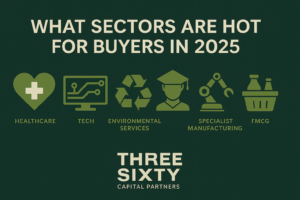Not all industries are created equal, especially when it comes to M&A.
While overall deal activity has remained steady, buyers in 2025 are more targeted, more cautious, and more strategic. That means some sectors are getting outsized attention, while others are seeing a slowdown.
If you’re a founder thinking about exit, investment, or succession over the next few years, understanding where that buyer heat is can make all the difference — especially when it comes to timing, valuation, and deal terms.
Here’s what we’re seeing in the market right now.
1. Healthcare and Aged Care Services
Demand in this space isn’t slowing down. An ageing population, workforce shortages, and ongoing public funding are driving sustained buyer interest, particularly for:
-
Community-based care providers
-
Mental health and disability services
-
Allied health and diagnostics
-
Tech-enabled or platform-based delivery models
Buyers are looking for scalable operations, strong clinical teams, and compliance-led leadership.
2. Software and Tech-Enabled Services
The tech sector isn’t bulletproof, but buyers are still active, especially where there’s clear recurring revenue and defensible niche positioning.
B2B SaaS, workflow automation, compliance tech, and industry-specific tools (e.g. for healthcare, logistics, or education) continue to draw interest.
Key buyer questions:
-
Can it scale without breaking?
-
Is it sticky with customers?
-
How lean is the cost base?
3. Environmental and Waste Services
Sustainability isn’t just a buzzword, it’s a buying mandate for many funds and corporates.
We’re seeing increased deal flow across:
-
Waste collection and processing
-
Recycling and circular economy businesses
-
Environmental compliance and remediation services
These assets often come with long-term contracts and essential service characteristics, making them attractive from a risk/reward perspective.
4. Education and Training Providers
With skills shortages across nearly every sector, training and upskilling platforms are in demand. We’re seeing particular interest in:
-
Industry-aligned training (e.g. trades, tech, healthcare)
-
Registered training organisations (RTOs)
-
Online or hybrid learning models
Buyers value regulatory compliance, government funding alignment, and student outcomes.
5. Specialist Manufacturing and Exporters
Manufacturers with IP, automation, and clear export growth are gaining traction.
This includes:
-
Niche component and OEM suppliers
-
Food and beverage producers with strong offshore demand
-
Precision engineering firms
Key here is margin quality, defensible market position, and resilience to supply chain disruptions.
6. Fast-Moving Consumer Goods (FMCG)
Well-run FMCG businesses are back on buyers’ radars, especially those with strong brand equity, proven distribution, and presence in premium or high-growth categories.
Hot sub-sectors include:
-
Health and wellness
-
Premium food and beverage
-
Sustainable and locally produced goods
Buyers are looking for scale, but they’ll pay for margin and brand if the fundamentals are right.
What’s Cooling Off?
Not every sector is red-hot right now. The following areas are seeing softer buyer appetite:
-
Generic retail with no differentiation
-
Hospitality without scale or IP
-
Construction contractors reliant on fixed-price work
That said, with the right story, financials, and team, great businesses still get attention.
Final Thought: Know Where You Stand
Founders in hot sectors may be closer to a premium outcome than they think. Even if you’re not planning to exit tomorrow, being aware of market interest today helps you prepare smarter, earlier, and with more options.
If you’re not sure where your business fits in the current landscape, we’re happy to share what we’re seeing.
Thinking about a possible exit or investment partner?
Let’s have a chat. Visit Three Sixty Capital or reach out for a confidential conversation.

